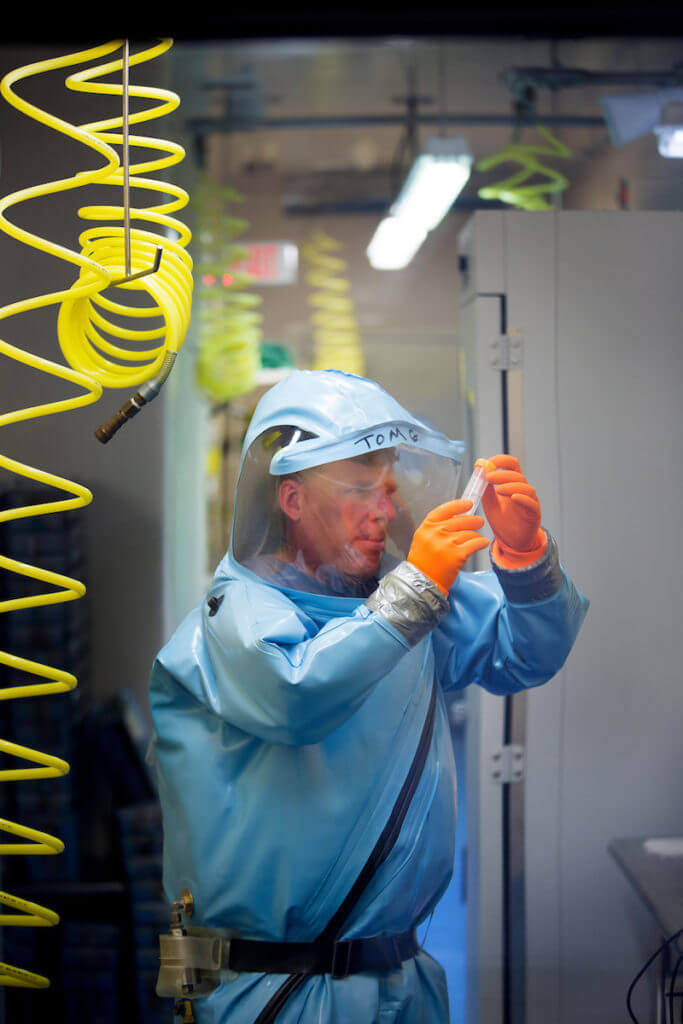The deadly Marburg virus recently surfaced in an explosive outbreak for the first time in Rwanda, where the Ministry of Health reported the first cases on September 27th. Since then, 46 cases have been reported, with 12 deaths. The majority of cases have occurred in healthcare workers. The source of the outbreak is under investigation.
Marburg virus, like its cousin, Ebola, can lead to large outbreaks with death occurring in up to 90% of those infected. Disease begins with an influenza-like illness including a high fever, weakness, sore throat, headache, body aches and sometimes a spotty red rash. After a few days, patients can move into a “wet” phase with significant vomiting and diarrhea. Near the end of the first week and into the second week of illness, the blood pressure can drop and victims go into shock, develop blood oozing from intravenous sites or sites of blood draws and ultimately may proceed to death. There are no licensed treatments or vaccines, although there are many candidate products being tested. The Sabin Vaccine Institute is providing an investigational vaccine to Rwanda for testing among healthcare workers at risk.
Marburg and Ebola viruses have a way of targeting unprepared healthcare facilities. The healthcare facility may be quiet, until a sudden explosive outbreak occurs, seemingly coming from nowhere. The typical sequence starts when an infected patient is admitted and not properly diagnosed, because many other diseases causing fever may appear similar early in illness. Caregivers, laboratory workers, as well as family members who have close contact with the patient or their diagnostic samples are particularly susceptible to infection, because the diseases spread through blood or body fluids. As the illness progresses, patients may expel large amounts of infected vomit or diarrhea, which hold high concentrations of contagious virus. Anyone handling blood is also at risk, due to extremely high viral concentrations.
Although cave-dwelling African fruit bats appear to harbor Marburg virus, the virus is stealthy. Initial human exposure may occur directly from contact with bats, other infected animals, such as a monkey or an infected human. Marburg first surfaced in 1967 in Marburg and Frankfurt, Germany and Belgrade, Yugoslavia, after African green monkeys were imported for scientific research. Thirty-one individuals who had contact with the infected animals, animal tissues, or direct contact with human victims became ill and seven died. Marburg virus has demonstrated the ability to resurface in the past few years in new and unexpected places. In 2023 alone, Equatorial Guinea and Tanzania experienced their first-ever outbreaks of Marburg. It also surfaced for the first time in Ghana in 2022.
In the 2013-2016 outbreak of Ebola virus disease in West Africa, cases in healthcare workers occurred in higher proportions compared to the rest of the population. Even more concerning was that the proportions of deaths in healthcare workers also exceeded those of the civilian populations. Due to the high risk to healthcare workers, organizations such as the CDC and WHO have developed guidelines on how to manage patients with Ebola and Marburg safely.
The key to preventing the spread of infection in a healthcare facility is to have a plan for baseline infection prevention, with the ability to ramp up to specific viral hemorrhagic fever precautions once infected patients are identified. This may sound simple, but it requires resources for the appropriate personal protective equipment, dedicated care teams and regular training. This is challenging to achieve in developed nations and even more so in resource-limited settings, especially those that have not previously managed infected patients.
The challenge of caring for patients infected with viral hemorrhagic fevers, such as Ebola, Lassa and Marburg has long been recognized. The United States Army Medical Research Institute of Infectious Diseases, USAMRIID, even created its own intensive care unit in the late 1960s, nicknamed the “Slammer” (because admission to the unit felt like being incarcerated) to care safely for patients infected with such viruses, or even an unknown, deadly pathogen. The facility had all the trappings of a biosafety level 4 “maximum containment” laboratory: caregivers donned blue space suits while providing patient care, the air exhausted from the unit was HEPA filtered, liquid waste was steam-sterilized before leaving the facility and caregivers exited through a decontamination shower.
The Slammer was the first of its kind and had the most sophisticated capabilities in the United States. Prior to the 2013-2016 Ebola outbreak, three other facilities became operational and cared for patients during the outbreak: Emory University Hospital in Atlanta; the University of Nebraska Medical Center in Omaha and the NIH’s Clinical Center in Bethesda, Maryland. Subsequently, these and other partner organizations in the United States, teamed up to form the National Emerging Special Pathogens Education Center, NETEC, to help train and assess hospitals for their preparedness to manage viral hemorrhagic fevers and other special pathogens. Since 2016, several similar biocontainment facilities have stood up at major medical centers across the country as concern for importation of exotic and potentially deadly emerging diseases has increased. The framework for response has divided hospitals into three tiers of response: frontline healthcare facilities to rapidly assess and triage potential patients; Ebola assessment hospitals to isolate and evaluate potential patients and Ebola treatment centers to be ready to provide definitive care safely of any diagnosed viral hemorrhagic fever patients.
The Marburg outbreak in Rwanda continues to evolve, with more patients continuing to be identified. Two individuals, who had potential exposure while in Rwanda were recently evaluated in Germany and found to be negative. Healthcare providers should be on alert for potential cases arriving in their hospitals, so that they are not caught by surprise and can activate appropriate safety measures, as needed. Hopefully, the vaccine clinical trial will provide useful data to move us on a pathway closer to having an effective vaccine. In the meantime, our best option is to prevent further spread of illness in health facilities and to provide supportive care for ill patients.
There’s a silver lining to a scary outbreak unfolding in Rwanda.
An outbreak of Marburg, a virus closely related to Ebola that can cause severe and often fatal disease, is spreading in Rwanda. As Africa struggles with compounding public health challenges, this one presents a rare silver lining: the chance to test new vaccines that could save lives across the continent in the future.
The first patient infected with the virus in the country died on September 8, the World Health Organization (WHO) said at a press conference Thursday. As of September 29, a total of 36 cases and 11 deaths have been reported, making it one of the largest Marburg outbreaks in history. Although most infections are among health care workers from two hospitals in Kigali, the capital of the East African country, seven of Rwanda’s 30 districts have seen cases. It is the first time the virus has been known to cause infections in Rwanda.
The WHO indicated the outbreak is highly likely to spread to neighboring countries, but the risk of further global spread is low. Typically, humans become infected when they come into contact with a Marburg-carrying Egyptian fruit bat, a species found across Africa, the Middle East, and parts of western Asia. Once a person has the virus, though, it can then spread to others through contact with bodily fluids or contaminated surfaces and materials, like clothing or bedding. This mode of transmission means that Marburg virus will not spread as easily as, say, Covid-19 or other respiratory diseases.
However, as we have seen in previous Marburg virus outbreaks, travelers returning from countries experiencing an outbreak can introduce the disease into their home countries. Already, one person who came into contact with an infected patient in Rwanda has traveled to Belgium, underscoring the possibility of isolated overseas cases.
Historically, Marburg virus disease is fatal in about 50 percent of patients, but in some previous outbreaks, the mortality rate has exceeded 80 percent. People experience high fever, severe headache, extreme fatigue, rash, bloody diarrhea, abdominal cramping, and unexplained bruising and bleeding from the nose and gums. Symptoms can appear anywhere from 2 to 21 days after the initial infection.
All previous Marburg virus outbreaks have occurred in sub-Saharan Africa, most recently in Tanzania, where there were eight confirmed cases and five deaths, and in Equatorial Guinea, where there were 16 confirmed cases and 12 deaths; both outbreaks occurred in 2023. Between 1967 and 2008, the US, Germany, Yugoslavia, and the Netherlands have reported Marburg disease among travelers returning from Uganda.
To date, there is no approved treatment or vaccine for Marburg virus disease, but there are at least four vaccines in development. All four have been effective in studies involving animals. A small, early-stage clinical trial in humans had promising results; however, study participants who received the Marburg vaccine were not exposed to the virus to test how protective the shot was. Two other vaccines for Ebola virus could also be effective against Marburg virus.
Researchers in Rwanda are preparing to submit protocols for phase 3 trials to a Rwandan ethics committee for approval. This would be an opportunity to expedite the development of Marburg virus vaccines and treatments and perform larger trials in a real-world outbreak.
If the trial moves forward quickly, the current crisis could allow scientists to identify a shot that protects millions of people in the years to come.
The WHO, Rwandan public health officials, and a group of scientists and institutes working on vaccine research met earlier this week to discuss quickly setting up a vaccine trial that could help quell the ongoing outbreak.
Of the vaccine candidates being developed, the most promising one that seems most likely to be tested if a trial moved ahead in Rwanda is the cAd3-Marburg vaccine developed by the National Institute of Allergy and Infectious Diseases (NIAID). Last year, the NIAID tested the vaccine for safety in humans for the first time in a phase 1 clinical trial.
Forty healthy adults received one of two different doses of the vaccine and were monitored for adverse reactions and to see if their immune systems produced antibodies, an indication that the vaccine would be effective if the individuals were exposed to the virus. The vaccine was deemed safe, and 95 percent of the participants had developed antibodies four weeks after receiving it. However, the participants were never exposed to the virus, so the vaccine’s practical effectiveness was not evaluated.
Earlier this year, the Sabin Vaccine Institute started a phase 2 clinical trial for the NIAID vaccine in Uganda and Kenya. Healthy adults will randomly be assigned to receive the vaccine or a placebo shot and then will again be monitored for adverse responses and antibody responses. Participants will also not be exposed to the Marburg virus during this trial.
Typically, if phase 2 trials are successful, scientists proceed to larger phase 3 trials and roll out the vaccine to a large group of people and then observe its impact when individuals are exposed to the virus. The emergency situation in Rwanda may accelerate this process. Scientists may move ahead with a phase 3 trial even though phase 2 results are not yet available.
Researchers and health officials have been preparing for this. Earlier this year, scientists from the WHO and 17 countries at risk for Marburg virus outbreaks developed protocols to test both vaccines and treatments during an outbreak. A phase 3 clinical trial in Rwanda would follow a ring vaccination strategy where contacts of infected people are vaccinated. The trial would have two groups, one group of contacts who are immediately vaccinated and then a second “delayed” group who are presumably vaccinated at a later time. Researchers would then compare the impact of the vaccine between the two groups.
Scientists may also test a treatment that uses antibodies, proteins made by the immune system to kill viruses and other pathogens, against the virus. One study found that treating animals such as guinea pigs and monkeys with these antibodies after they were infected with Marburg virus prevented serious illness and death. Medical workers successfully treated patients with antibody cocktails during previous Ebola virus outbreaks.
The WHO’s ethics committee has already approved protocols to test vaccines and the antibody treatment, a spokesperson told Vox. The next step is for these protocols to be approved by an ethics committee within Rwanda. Two Rwandan researchers have been selected to lead these efforts in the country.
One other hurdle remains. There are fewer than 2,000 total vaccine doses currently available. In April 2023, the Sabin Vaccine Institute had produced about 850 of those doses. Oxford University, which is developing another Marburg vaccine, had about 1,000 doses. Larger-scale production could be needed, especially if the outbreak becomes more widespread. Both the Sabin Vaccine Institute and Oxford University have existing manufacturing capacity for the Marburg vaccines and previously reported to the WHO that they could rapidly produce additional doses.
The Marburg outbreak has ignited amid a surging mpox outbreak in the region, which the World Health Organization declared an international health emergency in August. The Democratic Republic of the Congo, which neighbors Rwanda, is the epicenter of the mpox outbreak. (The DRC has not yet recorded any Marburg cases.)
Fortunately, Rwanda has one of the strongest public health systems in Africa and has only reported a handful of mpox cases. An estimated 90 percent of the population have health insurance, much higher than most of its neighbors. Rwanda also has a strong infectious disease surveillance system and a history of successfully containing outbreaks.
That makes it an ideal setting for testing a Marburg vaccine during the current outbreak — if public health authorities can move quickly. The race is on.

















